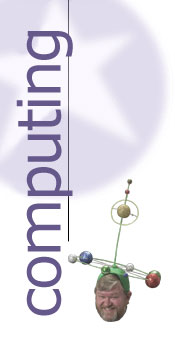The AT Waiting Game
by Lloyd Borrett
Today's Computers, PC Australia, May 1985
 |
|
Lloyd Borrett |
When will l IBM AT be released? I am asked this question
regularly, and unfortunately IBM Australia is playing this
one so close to the chest that the answers I give are not at
all precise. For all I know, by the time you read this the
PC AT may well have been announced in Australia.
But it is unlikely. IBM is unlikely to make the PC AT
available in Australia until it can guarantee continuity of
supply. The last thing IBM needs is the same bad feelings
and publicity generated with the premature release of the
XT. No matter how much money you had, there was a time when
you just could not buy the XT. It was not until IBM
Australia got the Wangaratta assembly plant going that the
XT became readily available in Australia.
IBM does not want history to repeat itself with the AT.
Supplies of these units are so tight that there is a
flourishing black market in the US, with second-hand units
selling for far more than the original price. There is
little chance of being able to guarantee supplies to
Australia.
So when will we see it? When Wangaratta starts assembling
the AT, or May-June, whichever comes first. Why May-June?
The investment allowance on new business equipment runs out
at the end of this financial year, and there will be a mad
rush to make the most of it. IBM would need very good
reasons not to make the most of this opportunity.
OK, let us assume you will be able to get your hands on
an AT. Here are some of the factors to be considered in such
a purchase.
First, forget about all of that bad press the AT has
received in Australia. Most of it was ill informed, and the
rest just sensationalised a few problems some users had
early on in the US. They were reported as failures of the
IBM 20¬megabyte fixed-disk drive. My sources, and personal
experience, suggest the symptoms were problems with the
fixed disk, but that the causes were errors in the DOS 3.0
operating system, especially the BACKUP and RESTORE
programs.
Also, several programs written to run under DOS 2.0
corrupt the disk structure when used with DOS 3.0 on the PC
AT. Many appear to be working fine, but on exiting the
program and running CHKDSK the true story is revealed.
IBM has provided US dealers with corrected versions of
DOS 3.0, and most producers of offending programs have
released new versions. We are unlikely to see the offending
version of DOS 3.0 here, but application programs should be
verified as AT and DOS 3.0 compatible.
Second, there are shortages of key components -
specifically, the IBM 512K and 128K memory expansion cards,
and the 20-megabyte fixed-disk drives.
The base model of the AT, which doesn't have the
20-megabyte fixed-disk, is a lot easier to obtain, and it
has become quite common for dealers and customers to buy the
base model and add their own fixed-disk drives. The user
benefits from this as the often-used half-height drives
leave increased expansion capacity.
Third-party supplies of memory expansion boards are now
becoming available in the US. AST Research has an
enhancement card called Advantage!, which removes the need
for IBM's 128K memory card as well as providing up to two
serial ports, one parallel port, a games port, and three
megabytes of parity-checked memory. It is to be hoped that
Australian distributors will not be slow in getting
such cards out.
It is worth noting that most of the memory expansion
cards offering more than a megabyte use 256K memory chips,
which are not in common supply. The better cards allow the
use of 64K chips, but have provision to use 256K chips for
increased expansion.
Third, there are problems with the use of the
1.2-megabyte diskette drive that comes standard on the AT.
The special high-capacity diskettes required are in short
supply. That will change, but it will take time. This means
that you face the odious task of backing up a 20-megabyte
hard disk using more than 30 360K diskettes. No wonder tape
backup units have become popular.
If you have PCs or XTs that you want to have share data
via diskettes on the AT then you are in for more money. The
high-capacity diskette drive can read and write to 360K
format diskettes, but it cannot be guaranteed that the
drives on the PC and XT will be able to read them. That
makes addition of a 360K diskette drive to the AT almost a
necessity.
As if that is not enough, the 360K diskette drives used
in the AT use a different interface to those in the PC and
XT. So if you want to add a third-party 360K diskette drive
to your AT, make sure that it is compatible with the IBM
version.
Already a lot of people are awaiting the AT; they need
the added performance and capacity. Don't become one of
those who rush in blindly, and thus pay extra while the
suppliers learn the ropes.
The AT differs in many ways from the existing IBM models,
and it will take most suppliers some time to come to grips
with the implications of these changes. Take the time to
seek out someone who has done the pioneering work and learn
from them. Even then, as with all new technology, you may
still have to do just a little trail blazing yourself.
Lloyd Borrett is support co-ordinator for HiSoft
Australia, president of the Australian PC User
Association, founder of the Melbourne PC User Group, and
system operator of the PC Connection bulletin board.
Last modified: 6:59 am Thursday 25 September 2025
Local time: 4:36 pm Sunday 5 October 2025
|


